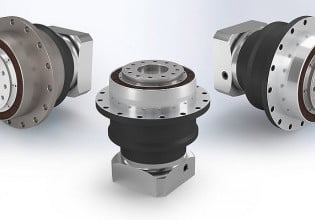Variable Air System Pressure with New AutomationDirect Transducers
When precise pneumatic control is required, on/off valves are insufficient. A new series of variable 4-20 mA valves from AutomationDirect provides more precise linear pressure control.
Behind many automated tasks is a solenoid communicating with a controller or PLC to provide air power to the moving mechanisms. However, most solenoid valves are confined to a binary on/off command which limits the use of air in some industries where precision is necessary, such as paper and paper conversion, HVAC, textile, and energy management.
A new series of electro-pneumatic transducers offered by AutomationDirect addresses these limitations by offering precise control over output air pressure, giving adjustability and precision.

New series of Metal Work Regtronic electro-pneumatic transducers. Image used courtesy of AutomationDirect
The Technology of Electro-Pneumatic Transducers
With two internal solenoid valves, these cutting-edge devices convert electronic signals (usually current or voltage, but occasionally data from Modbus or IO-Link channels) from PLCs or controllers into precisely regulated linear output pressure. The dual solenoid design also eliminates continuous supply air consumption, effectively reducing operational costs for enhanced efficiency.
Electro-Pneumatic Transducer Specs
The new line of Metal Work Regtronic transducers from AutomationDirect boasts a versatile range of features, including a maximum output pressure of up to 145 psig. Tailoring to diverse pneumatic load requirements, models are available with low flow and exhaust capacity for small-volume applications and high flow and exhaust capacity for swift responses in large-volume scenarios making it suitable for many high-production automation systems.
I/P transducers convert a 4-20 mA current signal (I). Similarly, E/P transducers serve the same function as I/P transducers but they instead accept a 0-5 or 0-10 volt (E) input instead of current. These transducers act as the interface, translating electronic signals into precise pneumatic control. Much like sensors and switches used in manufacturing, these transducers offer a fundamental bridge between electronic signals and real-world property, enabling versatile control capabilities across diverse applications.
Designed to meet the demands of various industries, the Metal Work Regtronic transducers hold an IP65 environmental protection rating. This ensures resilience against dust and water in harsh conditions. Their integration is further facilitated by easy panel mounting using optional mounting bracket accessories. With a starting price of $380, these transducers offer a cost-effective and sophisticated solution for precise pneumatic control.
Electro-Pneumatic Transducer Applications
- Pneumatic Valve Positioners
I/P and E/P transducer capabilities provide accurate modulation and adjustment of valves in various industrial processes. The linear pneumatic output pressure translates into consistent and reliable valve positioning.
- Air Cylinders
These transducers provide reliable and repeatable operation for air cylinders, ensuring consistent and controlled movement. The ability to convert electronic signals into linear pneumatic pressure allows for accurate and synchronized actuation of air cylinders.
- Damper and Louver Actuators
Electro-pneumatic transducers excel in providing precise control for damper and louver actuators providing efficient airflow control. This precision is vital for applications in HVAC systems or industrial processes, where maintaining optimal air circulation and environmental conditions is paramount.

The package and documentation included with the new electro-pneumatic transducers. Image used courtesy of AutomationDirect
Additional Transducer Features
Electro-pneumatic transducers come equipped with a representative output signal of 0-10 V or 4-20 mA (varies by model), offering a precise reflection of the output pressure to verify proper operation. Two customizable digital output switches serve as alarm points, enhancing flexibility in system monitoring. A digital display is also integrated, eliminating the necessity for external pressure gauges and providing users with convenient real-time pressure readings.
These features collectively contribute to the user-friendly and advanced capabilities of the Metal Work Regtronic series electro-pneumatic transducers.






